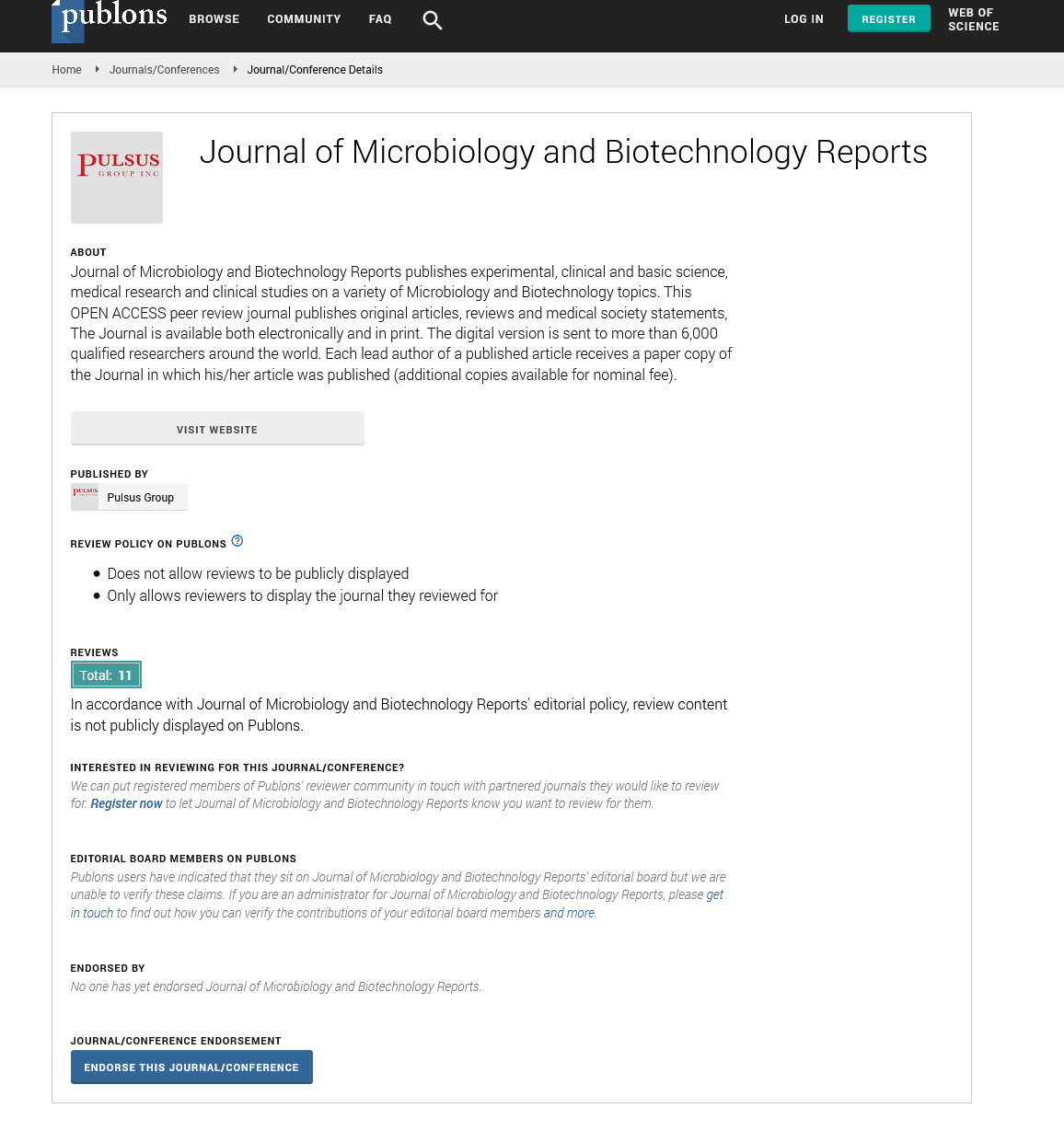Biochemical analysis of three native Dunaliella isolates with a focus on fatty acid content in the hope of finding a biotechnological application
Received: 27-Apr-2022, Manuscript No. puljmbr-22-4901; Editor assigned: 29-Apr-2022, Pre QC No. puljmbr-22-4901 (PQ); Accepted Date: May 18, 2022; Reviewed: 13-May-2022 QC No. puljmbr-22-4901 (Q); Revised: 15-May-2022, Manuscript No. puljmbr-22-4901 (R); Published: 20-May-2022, DOI: 10.37532/ puljmbr.2022.5(3).28-29
Citation: Smith A. Biochemical analysis of three native Dunaliella isolates with a focus on fatty acid content in the hope of finding a biotechnological application. J Mic Bio Rep. 2022; 5(3):28-29.
This open-access article is distributed under the terms of the Creative Commons Attribution Non-Commercial License (CC BY-NC) (http://creativecommons.org/licenses/by-nc/4.0/), which permits reuse, distribution and reproduction of the article, provided that the original work is properly cited and the reuse is restricted to noncommercial purposes. For commercial reuse, contact reprints@pulsus.com
Abstract
The biochemical makeup of three isolates, Dunaliella sp. ABRIINW-B1, -G2/1, and -I1, is described in this work in order to assess their biotechnological potential. The protein content of Dunaliella sp. ABRIINW- G2/1 and -I1 was outstanding (40 percent dry weight). Dunaliella sp. ABRIINW-I1 has a pigment fraction of 3.2 percent, which was mostly made up of chlorophyll a (1.9 percent) and carotenoids (0.8 percent) (1.1 percent). The lipid content of Dunaliella sp. ABRIINW-B1, -G2/1, and -I1 was 42, 36, and 47 percent, respectively. The isolates' inclination to store energy and carbon mostly in lipid form was evidenced by their high lipid and low carbohydrate (4%-7%) content. The isolates' lipid profiles showed an appropriate n3: n6 ratio and health indicators. Dunaliella sp. ABRIINW-B1 and -G2/1 have prospective uses in the food and freshwater aqua feed industries, according to biochemical study. While Dunaliella sp. ABRIINW-I1 showed tremendous potential in the nutritional, pharmaceutical, and marine aqua feed industries due to acceptable pigment, protein, and lipid levels comprising very-long-chain polyunsaturated fatty acids.
Key Words
Dunaliella, Nutraceutics, Pharmaceutics, Aquafeed
Introduction
Alternative resources are explored in support of ecologically responsible and protective measures as the population grows, outgrowing nutritional and energy demands, and the limitations of conventional sources. Furthermore, if not maintained feasibly, the general preference for natively produced food and health supplements over chemically generated alternatives leads to undue strain on the environment. Microalgae emerged as the major alternative and sustainable supply forwards because of the availability of different and unique metabolites with exceptional biological and pharmacological characteristics, as well as an environmentally friendly production technique that does not compete with the agriculture business. Microalgae are vastly underutilized resources with the potential to revolutionize biotechnology shortly, benefiting human nutrition and health, as well as global marketing. As the community and fundamental components of microalgal origins become more understood, important bioproducts with microalgal origins are becoming more widely used. Dunaliella microalgae are unicellular photosynthetic microorganisms with unique physiological characteristics.
This alga is a rich source of bioactive elements such as lipids, proteins, and carbohydrates, in addition to the large accumulation of carotenoids. Because of differences in cellular function, the compositional ratios of each component within a cell vary by species and even strain. As natural antioxidants, ant carcinogenic, antidiabetic, antiangiogenic, antihypertensive, anti-inflammatory, anti-obesity, and cardioprotective agents, microalgal pigments play a critical role in human health. Microalgae proteins offer a comprehensive spectrum of Essential Amino Acids (EAAs), making them suitable for use in processed meals, health functional foods, and aquaculture feed. Enzymes, antibodies, biosensors, antibiotics, and biocatalysts in food processing are examples of biotechnological uses in analytical, diagnostic, and therapeutic applications. Algal saccharides have also been found to have antibacterial, anticancer, antiviral, fibrinolytic, and anticoagulant effects. Microalgal producer organisms are a unique and sustainable oil platform because they accumulate huge amounts of lipids with a diverse Fatty Acid (FA) composition. The strain of microalgae influences lipid accumulation as well as the physical, chemical, and functional aspects of fatty acids. Long-chain and very-long-chain polyunsaturated fatty acids (LC-PUF As>18 and VLC-PUFAs>20 carbon chain) are produced by microalgae and comprise n6 and n3 fatty acids. They subsequently become part of the food chain after being consumed by fish, which is the subsequent source. Land plants and animals, which make up a large portion of the human diet, are high in n6 PUFAs and low in n3 PUFAs, which lack VLC-PUFAs. Because the human body is unable to convert -linolenic acid (ALA; C18:3) to n3 VLC-PUFAs, they constitute an important element of the diet. The fatty acid content of oily foods is a good indicator of their ability to prevent atherosclerosis and coronary illnesses, as well as cardiovascular problems and plaque aggregation. VLCPUFAs, like pigments, proteins, and polysaccharides generated from microalgae, can be used as functional food additions and health supplements. Microalgae are utilized in aquaculture feed composition, which increases the nutritional content of the meal and helps human health. Studies on the Dunaliella genus, like those on other microalgae, are frequently based on well-known species, leaving local isolates unexplored. The biochemical makeup of three indigenous Dunaliella isolates was characterized in this study to assess their biotechnological potential.
The investigations on native isolates and their biochemical constituents would make a significant contribution to the dissemination of a collection of isolates with a diverse range of uses.
Conclusion
The biochemical makeup of three isolates was determined in this study, indicating that they have potential use in the nutraceutical, pharmaceutical, and aquaculture sectors. Dunaliella sp. ABRIINW-B1 and -G2/1 demonstrated potential applicability in the food and freshwater aqua feed sectors owing to medium to high protein and sufficient lipid content with high n3 LC-PUFAs and appropriate health indices. The isolate Dunaliella sp. ABRIINW-I1 is well suited to the nutritional, pharmaceutical, cosmeceutical, and marine aqua feed sectors because of its high bio pigment, protein, and lipid content, which includes VLC-PUFA and n3 VLC-PUFA. Because Dunaliella sp. ABRIINW-I1 is a unique Dunaliella isolate capable of synthesizing both DHA and EPA, complementary optimization experiments may be conducted on it. In the isolate of interest, photobioreactor culture and environmental manipulation may enhance biomass production as well as volumetric productivity of the required biomolecules.





